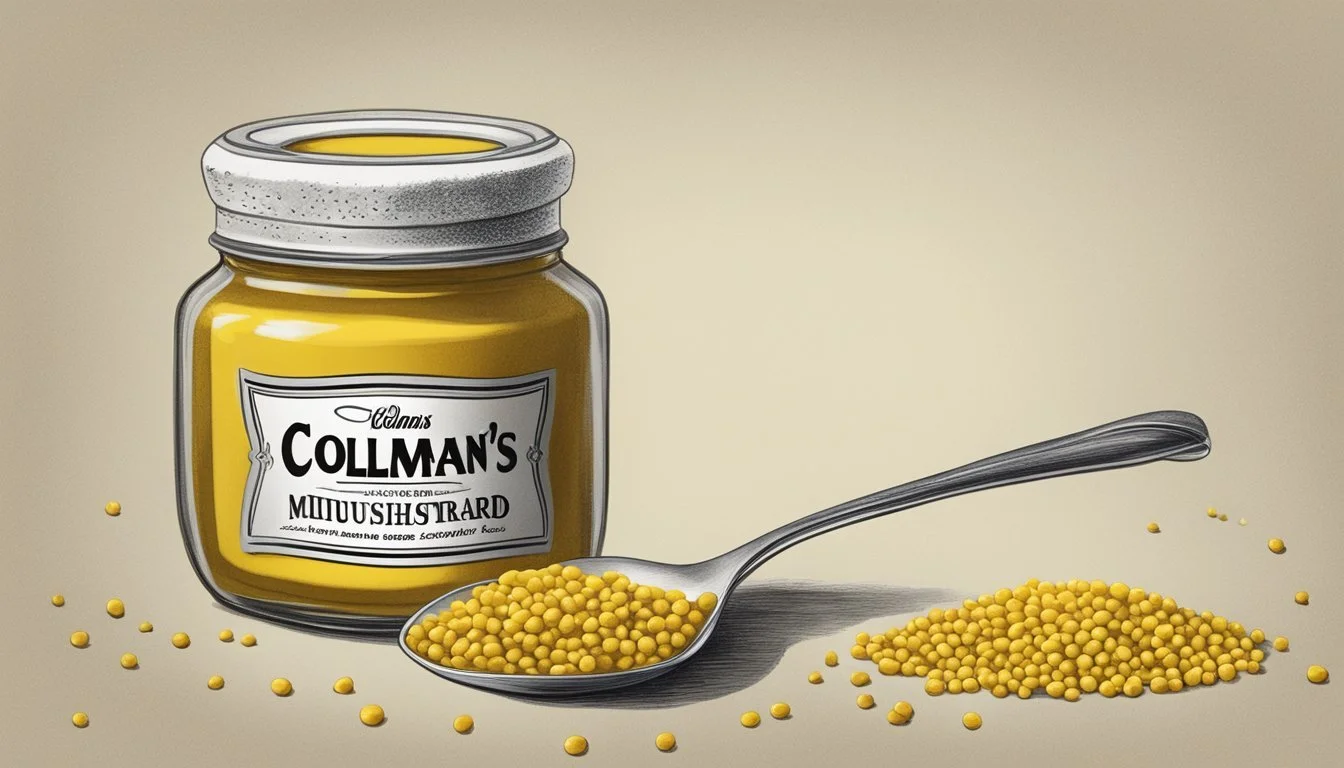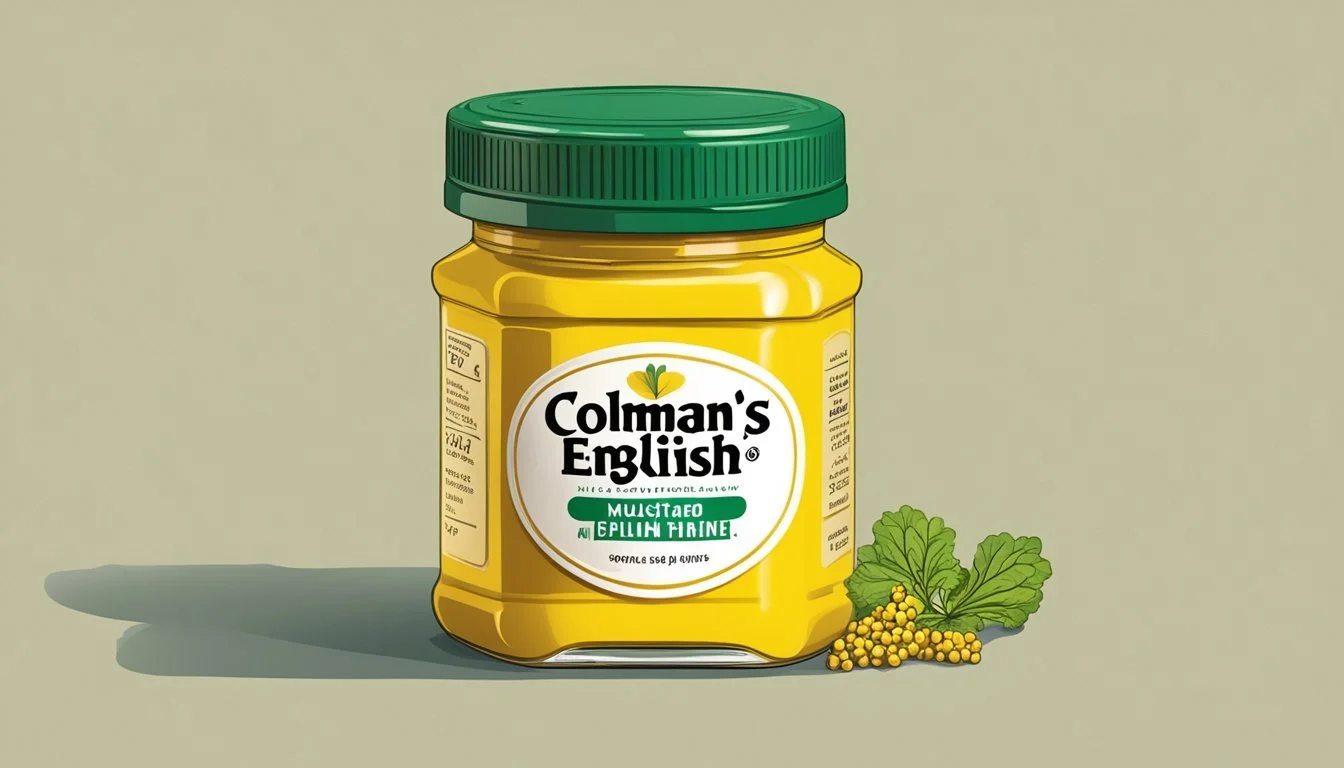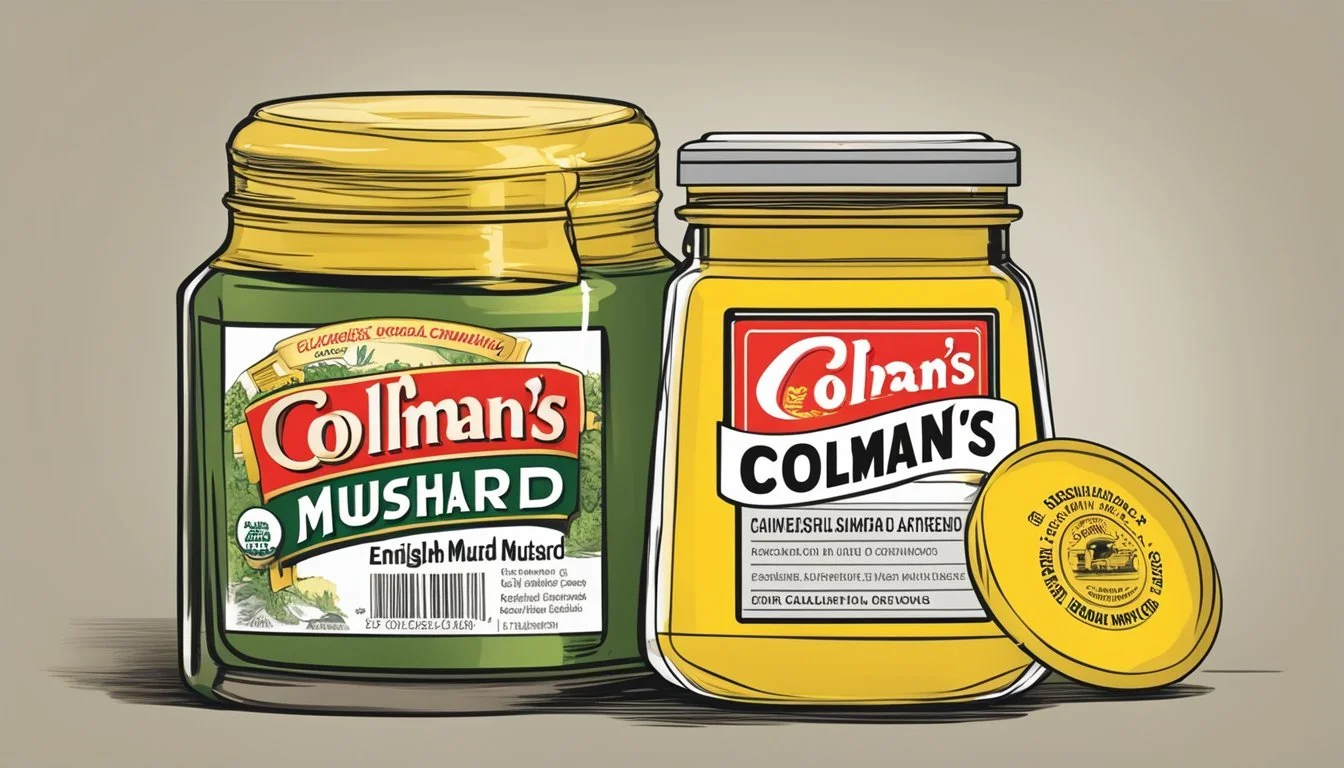How Much Colman's English Mustard Per Day Exceeds Healthy Limits?
English mustard, notably Colman's, is a condiment that has become a staple in British cuisine for its pungent flavor. Its intense taste means that it's usually consumed in small amounts, making it an unlikely candidate for overconsumption. However, like all foods, there is a threshold as to how much should be included in a daily diet. The key components to consider with Colman's mustard are its nutritional facts, such as calorie content, sodium, and the presence of fats, carbohydrates, proteins, and sugars.
The nutritional content of Colman's English Mustard per serving is relatively low, with a typical portion containing about 10 calories and minimal amounts of fat and protein. Despite this, the potential health impacts of mustard are not solely contingent upon its direct nutritional profile. Sodium—found in significant levels in many mustards—can pose health risks when consumed in excess. With regard to Colman's, the sodium content per serving is something consumers should be wary of, especially those monitoring their sodium intake for health reasons such as hypertension.
Understanding the appropriate portion size of Colman's mustard fits into a larger context of an individual's dietary habits and the importance of balanced nutrition. While mustard itself is not typically a food item associated with overeating, being mindful of its consumption is important within the scope of overall daily nutrient and calorie goals. Health guidelines and nutritional advice generally imply that moderation is a key aspect of any diet.
History and Background
Colman's Mustard, renowned for its bold flavor, has its roots in Norwich and was founded by Jeremiah Colman in the early 19th century. This section delves into the origins of the company and the legacy of its founder.
Origin of Colman's
Colman's of Norwich began its journey in 1814 when Jeremiah Colman took over a mustard manufacturing operation at a water mill in Bawburgh. The company quickly made a name for itself with its unique approach to mustard production—meticulously sieving seed up to nine times to ensure purity and a robust flavor.
Jeremiah Colman and Legacy
Jeremiah Colman's legacy rests not only on his mastery of mustard making but also on his business acumen and contributions to the Norwich community. Recognizing the quality of his mustard, Colman's received the illustrious Royal Warrant in 1866, cementing its status as a premier manufacturer. The company remained a family business for generations, with Colman's leadership ensuring consistent excellence and tradition.
Nutritional Profile
In assessing the nutritional value of Colman's English Mustard, one should consider the macronutrients, essential vitamins and minerals, and the detailed ingredients contributing to its overall nutritional makeup.
Macronutrients
The macronutrient composition of Colman's English Mustard is primarily made up of carbohydrates and proteins, with a smaller amount of fat. On average, a tablespoon (15 ml) serving contains:
Carbohydrates: Ranging from 0.8 to 1 gram
Protein: Approximately 0.4 to 0.5 grams
Fat: About 0.6 grams
These values equate to roughly 10 to 28 calories per serving, depending on the specific serving size.
Vitamins and Minerals
Colman's English Mustard contains a profile of vitamins and minerals, although they are present in relatively small amounts. It does contribute small quantities of:
Calcium and Potassium: Essential for bone health and blood pressure regulation
Iron: Crucial for blood production
However, specific information on Vitamin D is not readily provided in the search results, hence it is not detailed here.
Ingredients Breakdown
The ingredients found in Colman's English Mustard provide a more in-depth understanding of its nutritional value. The mustard is known to include:
Sugar: Typically contributes to the carbohydrate count
Spices: Which may include turmeric, a source of potassium
However, the exact amounts of these ingredients are not specified in the provided search results. Each component plays a role in the overall taste and nutritional density of the product.
Health Considerations
When considering the consumption of Colman's English mustard, it is important to take into account recommended daily intake values and potential dietary concerns.
Daily Value Guidelines
The % Daily Value (%DV) is a guide to understand the nutrient content of a food item based on a 2,000 calorie-per-day diet. For Colman's English mustard, the nutrient content per teaspoon (5g) is as follows:
Calories: 10 cal
Total Fat: Not specified but generally low
Saturated Fat: Not significant
Trans Fat: Not present
Cholesterol: Not significant
Sodium: Not specified but can be considerable
Dietary Fiber: Not present
The calories in Colman's English mustard are relatively low, meaning it is not a concern for calorie control in typical servings. However, mustard can contain notable amounts of sodium, which should be monitored to avoid exceeding the recommended daily intake of less than 2,300 mg for a standard diet.
Potential Risks and Allergens
Mustard can pose risks to certain individuals with allergies, as it contains mustard seeds which are a known allergen. Furthermore, the presence of turmeric, used in Colman's, may also cause adverse reactions to some. While mustard is generally safe in food amounts, larger quantities may lead to gastrointestinal distress or interfere with certain medications.
Individuals should remain aware of their own dietary restrictions, and consider the mustard's possible impact on their overall nutrient intake, especially regarding sodium and potential allergens.
Usage Recommendations
Determining the ideal amount of Colman's English Mustard to use daily involves considering both its potent flavor and nutritional content. It's crucial to approach this condiment with restraint to avoid overpowering dishes and exceeding the preferred dietary intake.
Serving Size and Moderation
When it comes to Colman's English Mustard, the serving size is typically measured in teaspoons (tsp). Moderation is key, as mustard is a strong condiment. An appropriate serving size can be about 1 tsp, which provides a balance of flavor without overwhelming the taste buds or dishes it accompanies. Excessive consumption could lead to a high intake of sodium and potentially upset the balance of one's diet.
Serving Size:
1 tsp (5g) of mustard is common
Daily Recommendation:
Limit to a few servings per day, depending on individual dietary needs
Culinary Uses
Colman's English Mustard is versatile and can be used in various culinary applications. It can enhance the flavor profiles of roasts, sandwiches, and can be a key ingredient in dressings and vinaigrettes. Due to its concentrated flavor, it should be used sparingly to complement rather than dominate the dish.
Culinary Applications:
Sandwiches: A thin spread on the bread adds zing to the meal.
Roasts: A small amount can be applied as a crust or glaze.
Dressings/Vinaigrettes: Whisked with oil and vinegar, it adds a spicy kick to salads.
By adhering to the recommendations for serving size and considering the culinary context of mustard usage, one can enjoy the robust flavors of Colman's without overindulgence.
Product Information
This section provides detailed information on Colman's English Mustard, focusing on the product's labeling, packaging, and the insights gathered from customer experiences.
Labeling and Packaging
Colman's English Mustard is presented in a distinctive container, with each holding 3.53 ounces of the product. The label on the container provides essential nutritional facts. For example, a 1 teaspoon (5g) serving contains:
Calories: 10
Total Fat: 0.6g
Total Carbohydrate: 0.8g
Dietary Fiber: 0g
Sugars: 0.5g
Sodium: 180mg
Fiber content is not applicable in this context as the mustard primarily provides negligible fiber. It is also important to check the label for potential allergens, as it may contain wheat derivatives and mustard.
The packaging design of Colman's Mustard has maintained its classic appeal, denoting a rich heritage associated with its country of origin, which is often perceived as a seal of quality by customers.
Customer Insights
Customer reviews often highlight the flavor intensity of Colman's English Mustard, which comes in both original and powder form. The powder form allows consumers to adjust the potency of the mustard according to their preference.
Customers frequently note the size of the container and the number of servings per container, with an average of 20 servings. These quantifiable metrics can aid consumers in identifying the daily amount of mustard that best fits their dietary preferences and nutritional needs.
Comparisons and Alternatives
In the selection of mustards, Colman's English Mustard stands out due to its strong, pungent flavor, setting it apart from its counterparts. It's crucial for consumers to understand the differences with other mustards and the substitutes available to balance a dish's flavor profile appropriately.
Colman's vs. Other Mustards
Original English Mustard: Colman's English Mustard, known for its sharp, fiery taste, is made from a blend of yellow and brown mustard seeds. This type results in a very hot flavor profile, distinct from most other mustards.
Dijon Mustard: Originating from France, Dijon mustard generally has a milder, more complex taste with a touch of acidity. It's typically made from brown or black mustard seeds mixed with wine.
Yellow Mustard: Commonly found in the U.S., yellow mustard - often referred to as American mustard - is milder compared to Colman's. It's made with white mustard seeds and turmeric, which give it a bright yellow color and a more subtle flavor suitable for a variety of dishes.
Horseradish: Although not a mustard, horseradish is sometimes used for a similar kick. It's a root vegetable prepared as a condiment and has a sharp, peppery flavor that can also be quite potent.
Substitutes for Colman's Mustard
When a recipe calls for Colman's Mustard, but one seeks an alternative, several substitutes might fit the bill:
For robust flavor, consider using a smaller amount of horseradish to mimic the heat without overwhelming other flavors.
For milder dishes, substitute with Dijon mustard, which will provide a less intense heat and a tangy note.
When using substitutes, it's important to adjust measurements to account for differences in flavor intensity. As a rule of thumb:
Replace 1 tablespoon of Colman's Mustard with about 2 teaspoons of Dijon to keep the flavors balanced.
Horseradish should be used sparingly, starting with half the amount of Colman's called for and adjusting to taste.
Storage and Shelf Life
When considering how much Colman's English mustard one can consume daily, understanding its storage and shelf life is essential. This ensures that the mustard maintains its quality and flavor over time and remains safe for consumption.
Preservation Techniques
The shelf life of Colman's English mustard can be maximized through proper preservation techniques. Mustard should be stored in a cool, dry place such as a pantry before opening. After opening, refrigeration is crucial to preserve its freshness. Preventing the introduction of contaminants by using clean utensils can also help extend its shelf life.
State Preservation Method Unopened Store in a cool, dry place Opened Refrigerate and use clean utensils to avoid contamination
Best Practices for Freshness
For Colman's English mustard, the manufacturer provides a best before date to indicate peak flavor quality. It is recommendable to consume it within this time frame for optimal taste. However, the mustard can remain safe to consume beyond this date if stored properly.
Shelf Life Overview:
Unopened: Up to 3 years (in a pantry)
Opened:
Fridge: 1 to 2 years (for best quality)
To ensure that mustard retains its characteristics, it should be kept tightly sealed when not in use and stored in the fridge to slow down any deterioration in quality. Regular checks for any changes in smell, taste, or appearance are advised to assess its quality.
Storage Location Container Status Shelf Life Pantry Unopened Up to 3 years Fridge Opened 1-2 years
Culinary Applications
Colman's English mustard is a versatile ingredient known for its bold and fiery flavor. In culinary applications, it serves as a robust condiment that enhances various dishes, from traditional British recipes to creative contemporary cuisine.
Recipes Featuring Colman's
Classic British roasts and sandwiches often feature Colman's English mustard for its ability to add a pungent kick. Here's how it's commonly included in some recipes:
Roasts: A dab of Colman's mustard can be spread over meats such as roast beef to create a flavorful crust.
Sandwiches: To add depth to sandwiches, mix Colman's mustard into dressings or use it straight for a more intense flavor.
Creative Uses in Cooking
Chefs and home cooks alike can incorporate Colman's into a variety of creative applications, including sauces, mash, and vinaigrettes:
Sauce: Blend Colman's with cream and herbs for a piquant mustard sauce, excellent for steak or chicken.
Mash: Stir into mashed potatoes for a warming, peppery twist.
Vinaigrette: Whisk together with olive oil, vinegar, honey, and a pinch of salt for a tangy salad dressing.
By including Colman's English mustard in these ways, cooks can add complexity and heat to their dishes in measured doses.
Additional Product Details
Colman's Original English Mustard is a condiment with a robust flavor profile and specific ingredients that impact its dietary implications. In understanding its composition, consumers can make informed decisions on the quantity that aligns with their dietary needs.
Thickeners and Additives
Colman's English Mustard includes several additives to maintain its consistency and shelf life. Xanthan Gum serves as a thickener to give the mustard its distinct texture. Citric Acid is used to preserve the tangy flavor and freshness over time. The product also contains Calcium Carbonate, which acts as an anti-caking agent, improving the texture and preventing clumping.
Dietary Considerations
When considering dietary needs, it's important to note that Colman's Mustard contains several ingredients that may influence dietary restrictions:
Salt: A common flavor enhancer that must be monitored to adhere to a low-sodium diet.
Turmeric: Included for its color and subtle flavor notes.
Wheat Flour: As a source of Niacin and an allergen to those with gluten sensitivities, wheat flour is a key consideration.
Health officials typically recommend that adults consume no more than 6g of salt per day, and one must take into account the presence of salt in various foods, including condiments like mustard. Consumers with gluten intolerance should also be aware of the inclusion of wheat flour in the product.











